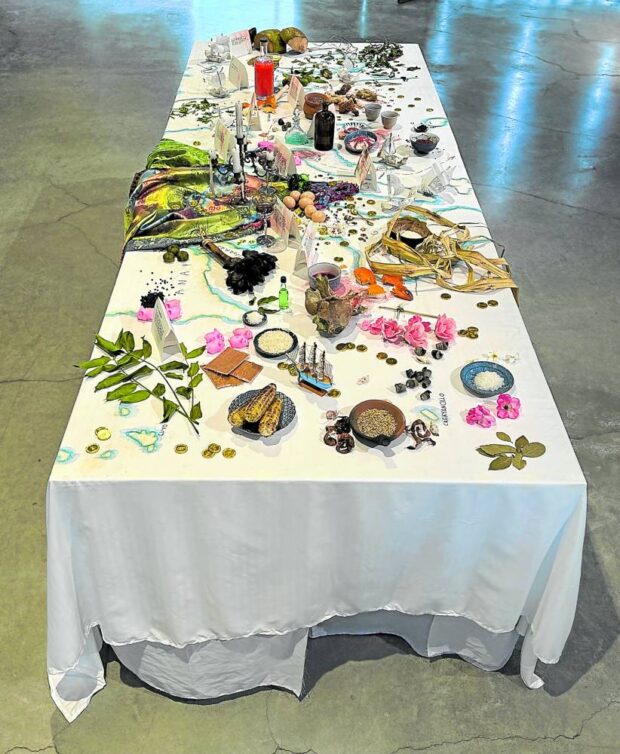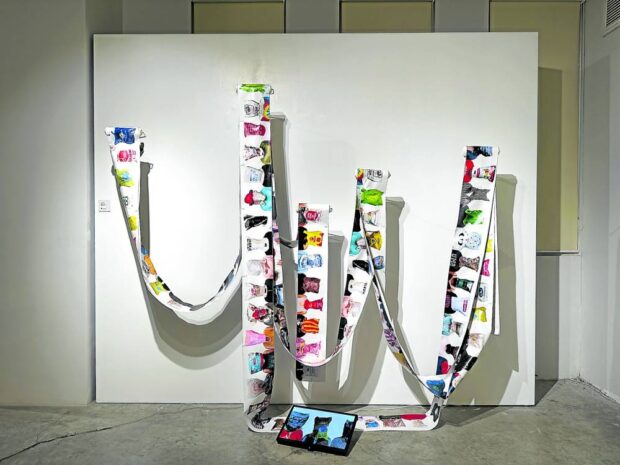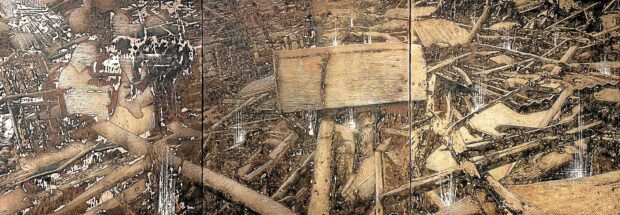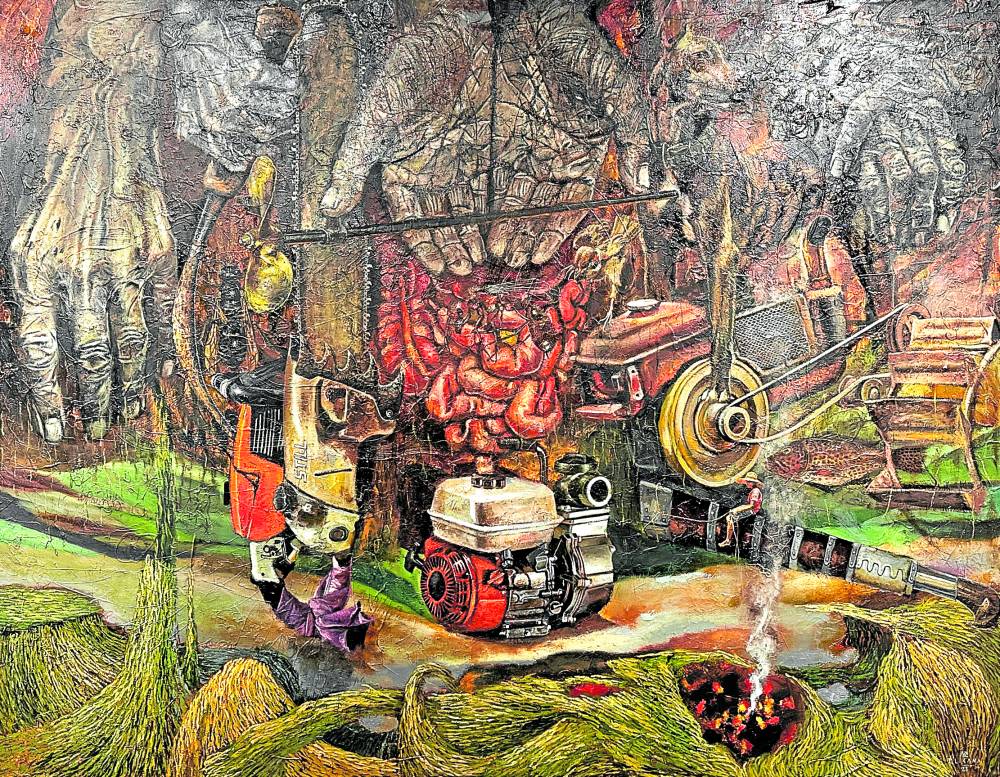
A recent artistic gaffe made the news when a student devoured the duct-taped banana of Maurizio Cattelan’s “Comedian,” on display in a Korean art gallery. Apparently, it was not the first time it happened. For whatever clout or controversy that stunt garnered, it raised again the eternal discussion on the definitions of art: Was the act of eating the artwork a performative response to the “essence” of the artwork? So which exactly is the artwork? And what is with the farcically saturnine act of devouring that banana?
Last May 18 saw the vernissage of a new exhibit at the Iloilo Museum of Contemporary Art (Ilomoca), an event which seemed to stoke the fire of the above questions.
Titled “Kaon Na Ta! A Melding of Visual Flavors,” the coming together of artworks from capital and periphery was aesthetics elevated to pictorial gastronomy. One may allude to a buffet of representations, as the sheer eclecticism of the displays was bewildering: the entangled odds and ends of the curious and the mundane, the juxtaposition of things neither here nor there, the coherence of matters sinister, saccharine and sarcastic, the meticulous attention to the nitty-gritty that would not have made sense had they been placed outside a negotiated space.

Loosely translated, kaon na ta is a Visayan invitation to partake, to feast—at least visually, to break bread and find meaning in the morsels and crumbs, and with the company of those who sit at the table. For a Panayanon, that invitation is a basic act of hospitality, one that should not necessarily go unheeded. Harking back to the homegrown tradition of meals and merienda eaten with family or friends, it evokes the idea that in the sharing of sustenance is also the sharing of the self: the act binds host and guest together.
Visual gastronomics
So what comprised Ilomoca’s feast of visual gastronomics? The works of 42 artists, among them Nunelucio Alvarado, Poklong Anading, Kristoffer Ardeña, Argie Bandoy, PJ Cabanalan, Valeria Cavestany, Charlie Co, Lena Cobangbang, Marvin Dalisay, Tracie Anglo Dizon, Jeanroll Ejar, Noel Elicana, Jun Orland Espinosa, Tyrone Dave Espinosa, Kinno Florentino, Arvin Flores, Bryan Liao, Kat Malazarte, Barry Matthew Namo, Manny Montelibano, Gerardo Tan and Jeona Zoleta, offered the viewer a smorgasbord of possibilities, projecting the spectrum of our realities: community, identity, social consciousness, the creative capacity and our everlasting propensity to recreate the archetypal.

If we take the culinary metaphor in a literal sense, we as audience commit to a certain form of consumption. However, what we would have consumed would be more of an experience rather than a mere takeaway: In ruminating the plethora of artworks in “Kaon Na Ta!,” we participate in a merging of the local and the external, in an artistic coming together of center and fringe where the personal and varied zeitgeister of artists are made manifest through canvas and cloth, pencil and paint, wood and wire, and a thousand other odds and ends keeping the eyes laden and the soul full. Of course, one cannot undertake a mere “reading” of the artists or their artistic processes through the artwork. Still, we can readily identify recurring themes running through the eclecticism of divides and conflicted spaces, and the seams where these meet. For one, the variety of styles or the media with which these are rendered is substantiation enough, but there is so much more that reach out to matters that verge on the academic and cerebral, or otherwise delve deep into the repressed and subjugated. For instance, audiences comfortable with classicism—or even abstraction—as the conventional of art receive a rude awakening in the introductory pieces of the exhibition. One steps onto the exhibit floor and is immediately greeted by Tan’s “Rendering,” an installation composed of a length of ikat cloth, patterned with troughs and crests in imitation of sound waves, sprawled in the middle of the floor. Flanking both ends of the textile are two screens which continuously play a recording of the weaving process. The whole is a simulacrum of visual tapestry, the visual and audio projection of the artistic process, and the imposing albeit deliberate awkwardness of the entire opus laid out on deck.
Extraordinary settings

Adjacent to it stands a postcard holder overflowing with snapshots of commonplace things taken from the most crudely extraordinary settings and angles. Crowning the vertical structure is an almost comical rejoinder that it is still a work in progress: MM Yu’s “Common Oddities” questions what is indeed common and what is indeed odd, to the chagrin or delight of the viewer.
Across is an untitled installation by Anading comprised of a vinyl strip draped on paint rollers, its serpentine form digitally rendered with faces covered in plastic bags: was this meant to be read as the superficial asphyxiating the essential, or would the train of plastic-covered faces be a brazen flex on how consumerism overwhelms identities?
Whatever political or social meanings the audience gleans from the artworks, these serve simply to affirm the function of art as commentary. Take Elicana’s “Under the Hardworking Hands” or Orland Espinosa’s subdued triptych “When there is light?” Spread throughout the canvas of the former is the surreal juxtaposition of metaphors evocative of the struggle of the labor movement, while the latter holds on to a monochrome palette even as the three panels project a barricade-like image, rubbing the irony into the rhetorical question.
Or perhaps a commentary on the Self, where the artwork becomes an introspective tool that questions the nature and identities of both artist and audience. The works of Tyrone Dave Espinosa, Dalisay, Florentino, Malazarte, Jayson Oliveria and Cavestany seem to put on trial—as art has always done before—the human condition, with all its flaws, frailties and follies. That these works throw back to the viewer these enduring queries without providing a clear response heightens the consciousness of preconceived boundaries and strata put to test by the range of media used.

Erotic nuances
Delving deeper into these lines of divide would be the repressed erotic nuances that surface in some of the artworks. Unabashedly, we find these in Robert Langenegger’s phallic baits while subtler hints of subdued carnal desires surface in Zoleta’s smaller etudes of acrylic and oil.
Establishing this motif through a social lens would be Jeanroll Ejar’s twin representations of paternal and maternal imagery, where phallic and yonic metaphors are astutely incorporated in the woodwork. While in all Freudian appearances there seems to be no battle of the sexes in the exhibition, the inhibition of viewers’ sensibilities, on the other hand, would be a much more contested space. Tongue in cheek, we recall Oscar Wilde’s pointed statement in his preface to “The Picture of Dorian Gray.” that the morality of art lies only in the perfect use of an imperfect medium—and nowhere else. Taking this contention of spaces and geographies to an almost literal level would be Cobangbang’s imposing “Pigafetta Picnic.” Set on a table covered with a map-like tablecloth traced with Visayan landmarks—Samar, Leyte, Bohol, Cebu, Panay, Guimaras and a smattering of adjacent islets—are a hodgepodge of objects aspiring to be historical artifacts.

In Cobangbang’s tableaux, geographical dimensions are delimited to items of (visual) consumption: Discarded crab shells, plastic eggs, grilled corn, chocolate coins masquerading as gold, fragile paper miniatures of galleons and caravels, and place cards scribbled with little notes of dates and events evoke a sense of history without claiming to be history itself. One discerns the whole with some nostalgia but is quickly reminded that this is still art and not a textbook lesson on history. As if to highlight this meeting of boundaries, “Kaon Na Ta!” spills out of the confines of the art museum. Beside Ilomoca, Emperador’s Brandy Museum showcased glimpses of color and design attached and laced onto brandy bottles. Also painted on the building’s walls are gargantuan murals by Romeo Lee, Jason Rufino, Pow Martinez, Janine Tolores, Marija Vicente, Arvin Nogueras, Da Da and Eyecan Creatives; they provide a prologue to the passerby, enticing the prospective museumgoer to try out the feast. Disturbing as the anthropomorphic images and body parts depicted in the artwork may be, their invitation is a clarion call and siren song: Inside lies more, and you are invited to stay and to partake. Curated by Marika Constantino, Rock Drilon and Manuel Ocampo, “Kaon Na Ta!” does not only arrange the buffet table where ideas and experiences can be freely laid; it likewise provides a mixing cauldron where these can meld and coalesce into shared spaces of debate and discussion, and gaping divides that leave much of the bridging—the interpretation and enjoyment—to the viewers. At the end of it all, the viewer might not be any nearer to finding an answer to what constitutes Art, but would that matter after the visual palate has tasted of the myriad of palettes displayed? The invitation of the exhibit remains: Let your eyes feed your soul; contemplate, savor and find meaning in the crumbs and morsels of the visual feast. Perhaps there was much comedic sense in the eating of that duct-taped banana, after all. —CONTRIBUTED INQ
The author is a member of the recently formed Iloilo Critics Circle. He is part of the faculty of Ateneo de Iloilo-Santa Maria Catholic. School.
###—###
#Byline2
@Inq_Lifestyle
By John Anthony S. Estolloso
@Inq_Lifestyle














































